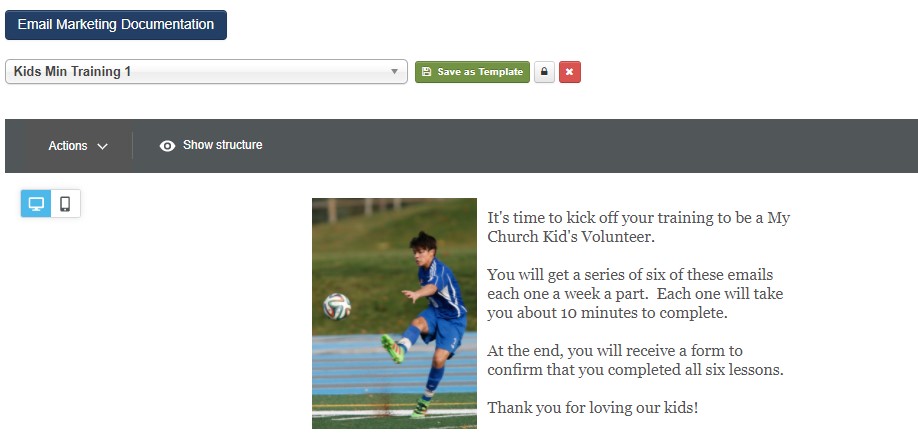 Last month I started this series on how to organize and build an effective volunteer system within Churchteams from start to finish. As a reminder, here are the seven parts of this system.
Last month I started this series on how to organize and build an effective volunteer system within Churchteams from start to finish. As a reminder, here are the seven parts of this system.
Today, we'll help you lay the tracks on which the volunteer engine gathers momentum. Here's how you use software to train your new volunteers.
The role of software from our perspective is NOT casting vision, building strategy, or developing content. Our role IS organizing and delivering all three. Here's how this works out practically in each of the 5 stops along the way to an effective training system.
- Develop content. Determine the content that you want your volunteers to digest during training. This can be anything from standard security training for children's volunteers to very specific instructions related where greeter's are to stand and what they should say.
Do some research, make a rough draft, test it, then refine it. You will most likely do all of this work in the context of your office software. - Choose how to present it. Now that you've got the content, how do you want to present it? Do you want to invite everyone to a gathering to present the content live? Do you want to video it to make it available on-demand as a webinar? Or can the content be delivered as a .pdf or series of slides for self-review? Each of these have obvious strengths and weaknesses.
Put the content into the presentation form you want. This may be a set of slides, a handout, shooting a video, or recording audio. If it's a series of emails and tweet-sized texts, build those templates inside Churchteams.
- Develop access. The next step is to connect your audience to the presentation. At this point your audience is a group of potential volunteers that have completed or are somewhere along the path of being interviewed and verified. If your presentation is live, use the RSVP feature in the group to invite them to accept or decline attendance. If the presentation is some sort of written or video content, email or text the content to the group. If the presentation is a series of written or video content, create a workflow to send it out at timed intervals. The workflow option can make training a fluid and ongoing process.
Virtually every part of the last three phases of training is handled in Churchteams. Putting together the pieces within the software helps you successfully organize and deliver your content. - Determine benchmarks. Unlike most of the other steps in your volunteer system, it is natural to want to benchmark completion of training with a specific date. This is typically a custom member attribute.
If the training is live, have participants check-in to get a name tag which also takes attendance; or manually take attendance like any small group. This is almost essential if the training is multiple live sessions so that you can know which sessions each person attended.
If the training is virtual include a link at the end of the content or in the final email to either send an email or complete a form (event registration) affirming their completion.
Take advantage of the "Update Member Data" option within the group to select those people who've completed the training, update the attribute that benchmarks their completion date, and then transfer them to the group or team on which they are now qualified to serve.
- Follow up. If you use the "Update Member Data" option mentioned above, you can transfer people to their volunteer team. This essentially registers them for this new "group" and notifies the leader that someone has been added to the team. If follow-up needs to be more specific for each individual, add a Note to their member profile and assign follow-up to yourself or someone else as needed.

Your volunteer system is gathering steam. Your new volunteers are on-board and you've laid the rails for them to run on. Next week we'll transition from train to schedule. My question for you, "should the train metaphors stop or keep on rolling?"



